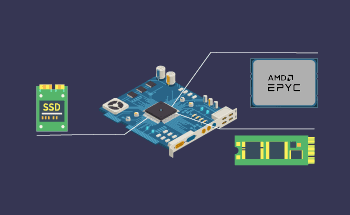The Limitations of Traditional SAN Architecture at Scale: Critical Shortcomings
11:49, 11.04.2024
SAN refers to a storage area network and consists of creating a network of storage devices that can be used as a shared storage pool for multiple servers. SAN is one of the common solutions for delivering storage in network architectures that are spread nowadays and is considered a particularly potent and reliable option. Nevertheless, it’s also not free from pitfalls, so you have to consider them as well before opting for SAN as a solution for your own projects. In today’s article, we want to have a look at some essential weak spots of SAN to help you in your considerations.
Speed as a Core Advantage of SAN
SAN is distinguished by an exceptionally high level of speed and performance, especially if compared to other options. However, this performance comes with a price and has certain particularities, which make it not a solution for every case.
Unveiling the Pros of Storage Area Networks
Among the competitors of the architecture, SAN generally provides the highest level of performance. Let’s compare it with some alternatives to see its pros and cons.
First, another common architecture NAS is designed to work as NAS devices whereby storage traffic is distributed by means of a LAN. This solution is pretty affordable and easy to set up. Despite this, it won’t provide you with high-speed rates due to network bandwidth limitations. Therefore they are usually chosen for environments of a smaller scale.
SANs in turn are specifically designed for storage and to perform fast. Instead of a LAN, SAN employs a Fibre Channel connection for transmitting storage traffic. This way, servers can access the storage directly on the block level, which eventually is a much faster approach.
Besides that, new storage instances and switches can be seamlessly added to already existing architectures, which means that scalability is easy, too.
Compared to another storage architecture, DAS, SAN allows for much more efficient storage use. DAS suggests that each server has its own disks, which are then connected to a shared filesystem. Since you cannot figure out, how much space will be needed by every server, some part of the storage space will lay idle on some servers, while other servers may instead hit the storage limit. When it comes to SAN, the storage of several servers is presented as a single pool of resources that can be allocated to servers that need them most.
Another prerequisite of SAN is that it was developed with an eye on redundancy to provide a failure-resistant environment. This way, if one of the switches fails, storage traffic will follow a different way so the entire system won’t collapse.
Limitations of Storage Area Networks
Cost: Power comes with a price, and SAN architecture is not an exception. To build a hardware environment with high performance and redundancy, you have to invest a great deal of resources and regularly maintain it.
Complexity: SAN is not a simple solution to deploy, so it will require a great deal of expert savoir-faire. This means, that if you want to deploy a SAN-based environment, you’ve got to have a number of competent employees in your team.
Real-world Applications: Use Cases for Storage Area Networks
SAN is by default a solution for larger scales. You want to deploy it with you deal with a large data center environment and want the to be as flexible and reliable as possible. This is often the case with database hosting, so critical applications are always able to rely on the database.
In particular, SANs can be helpful when deploying virtual server environments. A potential problem of VMs is that they can end up competing for server resources, which can negatively affect their performance if it’s not controlled. SANs can be helpful in this regard by reallocating the storage resources from other servers to help servers that are short for them. Conversely, unused resources from one server can be implemented to assist other servers. The fault tolerance of SAN will also exclude critical failures.
Similarly, SAN can be a great solution for virtual desktop environments. Virtual desktops are somewhat similar to virtual servers but are only a desktop environment that can be used for remote access, centralized management, and efficient use of computing resources. SAN architecture can be an efficient way to provide additional scalability to a VDI environment.
Reasons to Reconsider Implementing a SAN
Although there are many usage cases where SAN architecture is a perfect solution, there are still many cases where you would better opt for a different solution.
The first aspect is the cost. As discussed, deploying a SAN architecture is necessarily associated with significant investments both from the financial and technical side. Therefore, there is a point in deploying SAN then and only then, when your organization can benefit from all of its potential and can afford it financially without spending too much budget. If there are some more high-priority aspects that are worth investing in for your organization, then you should probably postpone the deployment of SAN until a more favorable period.
Another aspect to consider is the scale of your business. If you deal just with a couple of servers or rely on the cloud, there is no way it can really benefit from SAN architecture, considering moreover the complexity and the cost of deploying this kind of solution.
The final aspect is maintenance. SAN needs regular maintenance by a crew with a high level of expertise in appropriate technical areas. If it’s not the case with your company and you can’t afford such a team for now, you should reconsider the deployment of a SAN-based environment in favor of other options, probably ones discussed, depending on the specificity of your projects.


